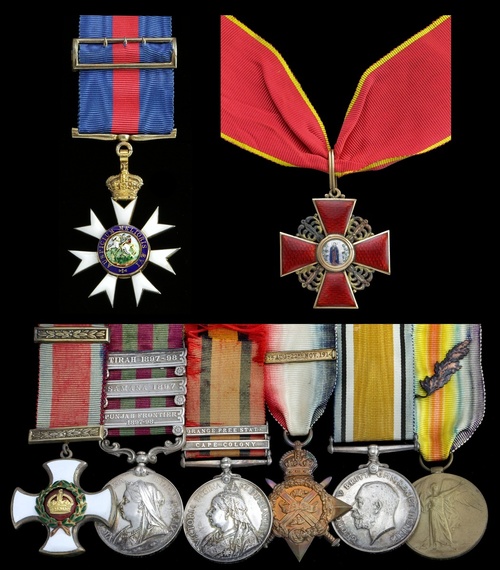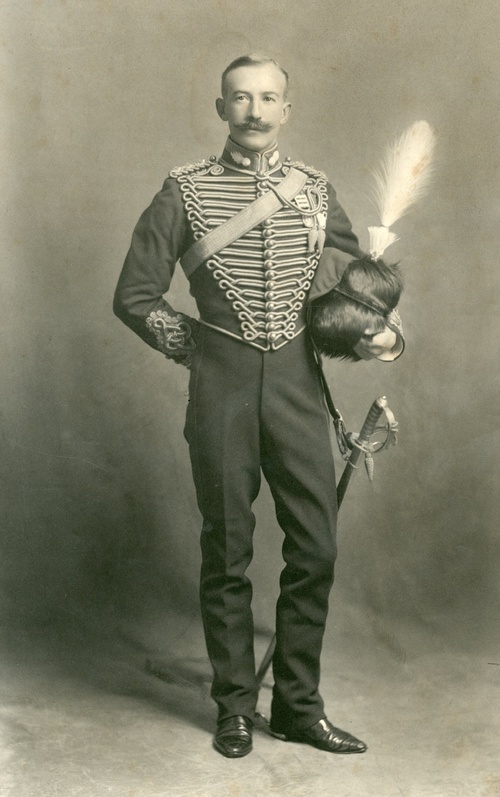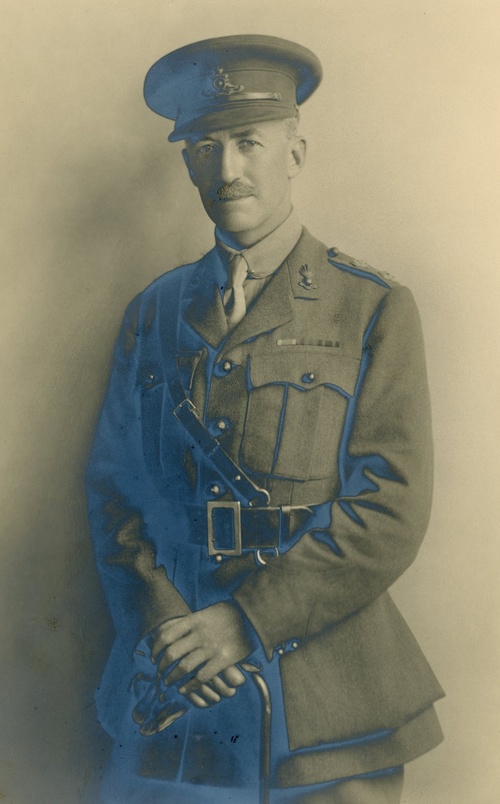Auction: 18001 - Orders, Decorations and Medals
Lot: 559
Sold by Order of a Direct Descendant
A fine Great War C.M.G., D.S.O. group of eight awarded to Brigadier-General W. G. Thompson, Royal Artillery
As a Lieutenant in 'O' Battery (The Rocket Troop), Royal Horse Artillery, he was wounded in four places at Slingersfontein in early 1900 and became a prisoner of war: anxious not to be sent to the main P.O.W. camp at Pretoria, he escaped from the State Hospital at Bloemfontein but was quickly recaptured
During the Great War he rose to senior command, winning a 'mention' for services on the Somme in 1916 and his D.S.O. as C.R.A. of 3rd Australian Division in the winter campaign of 1916-17
The Most Distinguished Order of St. Michael and St. George (C.M.G.), Companion's neck badge, silver-gilt and enamel; Distinguished Service Order, G.V.R., silver-gilt and enamel, with its Garrard & Co. case of issue; India General Service 1895-1902, 3 clasps, Punjab Frontier 1897-98, Samana 1897, Tirah 1897-98 (Lieut. W. G. Thompson, "O" By. R.H.A.), 'R.H.A.' officially corrected; Queen's South Africa 1899-1902, 2 clasps, Cape Colony, Orange Free State (Lieut. W. G. Thompson, "O" Bty. R.H.A.), re-engraved naming; 1914 Star (Major W. G. Thompson, R.H.A.); British War and Victory Medals (Brig. Gen. W. G. Thompson.), with M.I.D. oak leaf; Russia, Order of St Anne, gold, silver-gilt and enamel, mounted as worn where applicable, generally good very fine (8)
C.M.G. London Gazette 1 January 1919.
D.S.O. London Gazette 4 June 1917.
William George Thompson was born on 13 March 1871, the son of William Thompson of Deeping Stamford, Pilsgate House, Northamptonshire. Educated at Marlborough College, young William was commissioned 2nd Lieutenant in the Royal Artillery on 16 February 1893 and was promoted Lieutenant in 'O' Battery, Royal Horse Artillery (R.H.A.) in February 1896.
Off to war
Embarked for India, he took part in operations on the Samana and in the Kurram Valley, and afterwards with the Tirah Expeditionary Force in 1897-98 (Medal & 3 clasps); likewise in South Africa from October 1899 until being severely wounded in early 1900.
Hence his part in the operations in Cape Colony, south of the Orange River, including the actions at Colesberg on 1 January and 12 February 1900, when he had charge of a section of 'O' Battery's 12-pounder guns and acted in support of General French's cavalry.
Slingersfontein - multiple wounds and capture
Slingersfontein was an important position on the right flank of French's column. Here there was very little open veldt, but rather mile after mile of small kopjes that rose in countless numbers to create a labyrinth of rocky excrescences. The Boers knew the lay of the land and intended to extend their line on the right flank so as to harass British communications with Rensberg, which was at that time the main base of operations and Army Headquarters.
The British recognised this threat and Thompson found himself in January 1900 on reconnaissance duties, determining which koppies were held and in what force:
'We began feeling out toward our right flank, with the idea of getting round on the main road and, if possible, preventing the destruction of Norval's Pont bridge over the Orange River. I was out with my section of guns beyond a farm called Slingersfontein, but came under rather heavy fire and did not get very far.
Early on the morning of January 13 we were informed that a patrol had found a position dominating the row of koppies held by the Boers, who were stopping our advance. We were asked to send some guns to turn them off, and I was sent along with the man who had brought the information to see if we could get the guns there.
I rode out with my trooper. About two miles from our bivouac the going got bad and rather steep. We pulled up to have a look around, when "crack," we had a volley of about 20 rifles into us.
Both horses fell; both of us were hit. The trooper's horse fell on him and my right arm dropped. I tried to get under cover but was downed - one round in my ribs, one through my right thigh, two through my left thigh and the heel blown off my left boot.
I don't know whether I was unconscious for a time or not, but after a while I found that ants from a nearby nest had found my wounds and were giving me a very bad time. I tried with my left hand and my teeth to tie a dressing round the worst of them.'
Thompson was eventually picked up by a detachment of the South African Republican Police and taken to Colesberg, where his wounds were dressed. His trooper's spine had been damaged and he died four days afterwards. Thompson's right arm was useless for a time and he lost the use of his right leg below the knee.
After a short time, he was moved at night by bullock wagon to Norval's Pont, and then by train to Bloemfontein and put in the State Hospital:
'This was exceedingly well run by a Dr. Kellner and Matron Norris, with a staff of British colonial nurses. To their care I owe the recovery of the use of my leg.'
Nothing is known regarding the circumstances of Thompson's subsequent escape, but he appears not to have gotten far and was recaptured at Bloemfontein on 3 March 1900. His motivation was clear, however:
'We began to be anxious lest we should be moved to a prisoners' camp at Pretoria, and it was with tremendous relief that we saw in the evening of March 12 some rifle and machine-gun flashes as our relieving forces under General Roberts started to make its way round the east of the town.
Anyhow, we were not moved that night, and in the morning our advance troops entered the town. The Free State flag flying over the hospital was lowered by the hospital staff, and as I had been hit worse than the others, it was given to me by the matron.'
Thompson was admitted to Wynberg Hospital and thence embarked for home. He was mentioned in despatches (London Gazette 4 May 1900, refers).
Film star
Advanced to Major in February 1910, Thompson was given command of a special detachment of 1200 men in early 1914, his task being to pull-off a good show for a War Office film. It depicted his men travelling from Aldershot to London on the Special Corridor Train:
'The men were as fine a body of troops as one could wish to see. Attired in immaculate uniforms, with their buttons and every bit of metal polished up to the highest point of brilliancy, stalwart and happy looking, they certainly offered as good an advertisement of the Army as could be desired, and their jaunty bearing and precision of movement elicited the highest admiration of the onlookers. In addition, it has the imprimatur of the King and Queen and Queen Alexandra, who witnessed it last week and expressed themselves in every way satisfied.'
The Great War and beyond
Embarked for France in August 1914 - as a Major, R.H.A. - Thompson rose to senior command.
He won a 'mention' for his part in the Somme offensive in 1916 and, as acting C.R.A. of the 3rd Australian Division, is believed to have won his D.S.O. in the winter campaign of 1916-17. He was also awarded the Russian Order of St. Anne (London Gazette 14 January 1918, refers).
Placed on the Retired List in 1920, Thompson settled at Woodman Mead, Warminster, Wiltshire, but retained his former connections to the R.A. Coaching Club at Aldershot, where he had at one time been President. He also made numerous trips to India to shoot big game.
Having raised two daughters, Bridget and Lois, it is perhaps fitting that they decided to return the flag given to him when he lay seriously wounded in the State Hospital at Bloemfontein:
'The home coming of this old relic represents a gesture of goodwill from a British soldier who will never forget the kindly treatment which he received at the hands of his former foes, who, after seriously wounding him, spared no effort to save his life and then nurse him back to health.'
The General died in November 1944.
Sold with a quantity of original documentation and photographs, comprising:
(i)
Two original portrait photographs of Thompson in uniform, by Van Dyk, one framed, behind glass; another portrait photograph wearing his India and South Africa medal ribands; further photographs of him and his men on manoeuvres; and a silver photograph frame, maker's mark Birmingham, displaying the photograph of a young woman.
(ii)
Ephemera relating to the War Office film in 1914, together with a copy of orders to Thompson regarding logistics.
(iii)
Assorted newspaper cuttings relating to Thompson and his exploits in South Africa, including mention of his wounds and capture, and the return of the flag given him at Bloemfontein.
(iv)
A small scrap book album with further cuttings of notable events and technological advances from 1880 onwards.
Please see Lot 0000 for the recipient's miniature dress medals.
Subject to 20% VAT on Buyer’s Premium. For more information please view Terms and Conditions for Buyers.
Sold for
£2,900









